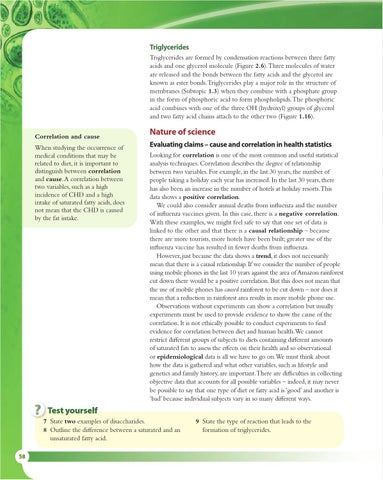Triglycerides Triglycerides are formed by condensation reactions between three fatty acids and one glycerol molecule (Figure 2.6). Three molecules of water are released and the bonds between the fatty acids and the glycerol are known as ester bonds. Triglycerides play a major role in the structure of membranes (Subtopic 1.3) when they combine with a phosphate group in the form of phosphoric acid to form phospholipids. The phosphoric acid combines with one of the three OH (hydroxyl) groups of glycerol and two fatty acid chains attach to the other two (Figure 1.16). Correlation and cause When studying the occurrence of medical conditions that may be related to diet, it is important to distinguish between correlation and cause. A correlation between two variables, such as a high incidence of CHD and a high intake of saturated fatty acids, does not mean that the CHD is caused by the fat intake.
? 58
Nature of science Evaluating claims – cause and correlation in health statistics Looking for correlation is one of the most common and useful statistical analysis techniques. Correlation describes the degree of relationship between two variables. For example, in the last 30 years, the number of people taking a holiday each year has increased. In the last 30 years, there has also been an increase in the number of hotels at holiday resorts. This data shows a positive correlation. We could also consider annual deaths from influenza and the number of influenza vaccines given. In this case, there is a negative correlation. With these examples, we might feel safe to say that one set of data is linked to the other and that there is a causal relationship – because there are more tourists, more hotels have been built; greater use of the influenza vaccine has resulted in fewer deaths from influenza. However, just because the data shows a trend, it does not necessarily mean that there is a causal relationship. If we consider the number of people using mobile phones in the last 10 years against the area of Amazon rainforest cut down there would be a positive correlation. But this does not mean that the use of mobile phones has caused rainforest to be cut down – nor does it mean that a reduction in rainforest area results in more mobile phone use. Observations without experiments can show a correlation but usually experiments must be used to provide evidence to show the cause of the correlation. It is not ethically possible to conduct experiments to find evidence for correlation between diet and human health. We cannot restrict different groups of subjects to diets containing different amounts of saturated fats to assess the effects on their health and so observational or epidemiological data is all we have to go on. We must think about how the data is gathered and what other variables, such as lifestyle and genetics and family history, are important. There are difficulties in collecting objective data that accounts for all possible variables – indeed, it may never be possible to say that one type of diet or fatty acid is ‘good’ and another is ‘bad’ because individual subjects vary in so many different ways.
Test yourself 7 State two examples of disaccharides. 8 Outline the difference between a saturated and an unsaturated fatty acid.
9 State the type of reaction that leads to the formation of triglycerides.
